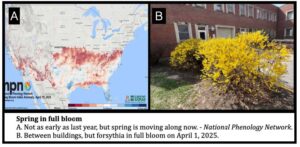Excessive and in some cases, abusive rainfall amounts; keys to soggy turfgrass management; winter injury potential causes and recovery, red thread, spring golf disease prevention Weather Spring, which officially started on March 20, is rolling along, and into mid-April temperatures in the region are ahead of statistical normal, but lagging somewhat behind last year. I appreciate and highly recommend the Growing Degree Day Tracker hosted by Michigan State University as a barometer for the progress of spring, and importantly the status of growing degree accumulation vs. the previous year. Flowering in the Lafayette area of the early bloomers has occurred, with forsythia leading the way and now dandelion flowers popping in yards throughout the area.
The winter of 2024-25 had near normal regional temperatures in the north and slightly below normal temperatures in the south. December was above normal, but with the new year came a marked shift in below normal temperatures in January and February. Importantly for us turfgrass managers, these frigid Arctic blasts were not accompanied by precipitation and snow cover. As noted below, we are getting reports and a few samples of winter injury on home lawns in northern IN as a result of this unprotected blast of cold air.
Click here to continue reading the Turfgrass Disease Report.
